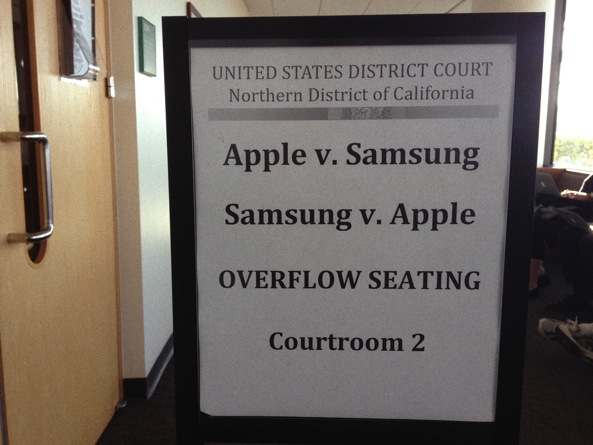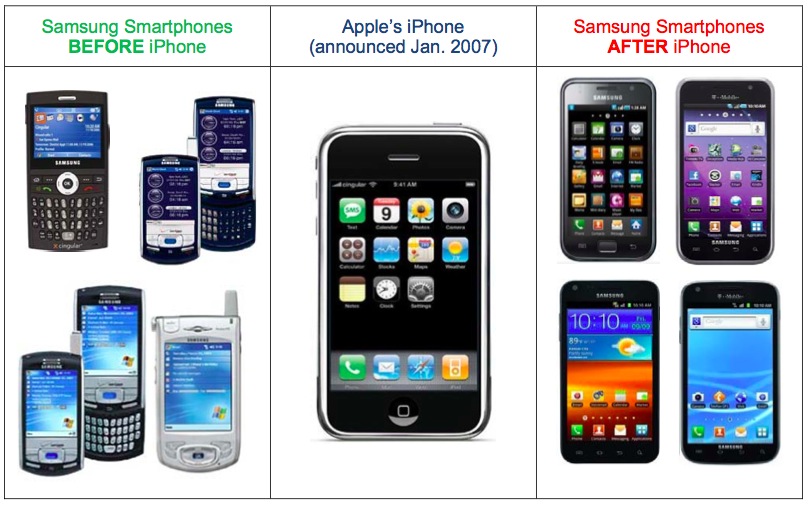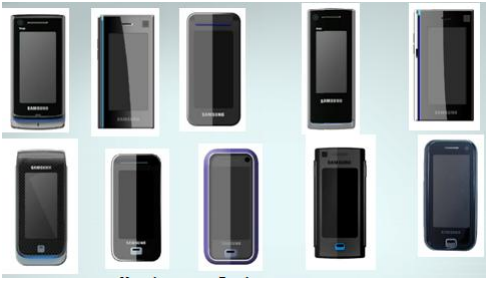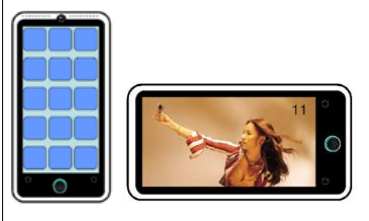With the ten-person jury selected, a plenty of tidbits hit newswires as Apple and Samsung locked horns this morning inside a San Jose courtroom. Samsung is basically saying that Apple didn’t invent the rectangle, while Cupertino insists that Samsung lifted the best iPhone ideas.
Before Apple could portray itself as a smartphone underdog in the opening remarks, the packed courtroom received an 18-minute video primer on how the patent system works, seen right after the break.
Coincidentally or not, in what could foreshadow a major design change for Android amid heating patent wars, Google has filed for an interesting patent which promises to bring radial menus to its mobile operating system and Chrome devices…
Apple began with an internal Samsung product analysis which said the iPhone’s hardware was “easy to copy” and an observation that a failed iPhone launch could have ended Apple as a company.
Per Apple’s lawyers:
Apple had absolutely no name in the field, no credibility. The iPhone was an entry that had it gone bad, could have ended the company’s future.
On January 9, 2007 when Steve Jobs and Phil Schiller went through that presentation, they were literally betting their company.
But first, here’s the 17-minute video overview called Introduction to the Patent System that usually gets shown to jurors in patent jury trials so they could get a better understanding of what patents are, how inventors get them, the role of the Patent and Trademark Office and why disputes over patents arise.
[tube]vZ1SBP8ul1s[/tube]
The video was developed with the assistance of an advisory committee of district judges and patent attorneys. It isn’t mandatory as the individual trial judge gets to decide whether or not to use this video in patent jury trials.
Back to the trial.
AllThingsD relays Apple lawyers’ words:
As we all know, it’s easier to copy than to innovate. Apple had already taken the risks. Samsung refuses to stop using Apple’s technology.
The copying, lawyers noted, began with Samsung’s Galaxy S smartphone.
Samsung attorney Charles Verhoeven fired back:
Unlike Apple, that makes only one kind of phone, Samsung makes all kinds of phones for all kinds of people. Apple didn’t invent that [rectangular smartphones]. That was already out there.
AllThingsD has more:
There has been an evolution in technology, Verhoeven said, with technology allowing for more features. “As that functionality increased, the entire industry moved to [larger screens].
No one, he said, was going to want to watch movies on tiny screens, so screens got bigger.
He also said:
It’s not just Samsung. The evidence will show it is the entire industry. Everybody does it in the commercial marketplace. There’s nothing wrong with that.
Samsung is not some copyist. Samsung is a major technology company that develops its own innovations.
Verhoeven also pointed out that the iPhone uses about twenty components made by Samsung:
The guts that make this phone work, the flash memory in the phone, the main memory in the phone, the application processor in the phone, they are all supplied by Samsung. Clearly, Apple thinks Samsung invented something.
Apple predictably in its opening remarks showed this graphics in an effort to prove that Samsung was in a “crisis of design” because of the iPhone, which Apple argues has had a lasting impact on all smartphones that have come after it.
An attorney for Apple asked, according to Reuters:
How did Samsung get to here in 2006 to here in 2011?
The Cupertino, California gadget maker argues the 22.7 million devices Samsung sold infringe upon its patents. These devices brought in $8.16 billion in revenue for Samsung, taking $2 billion in profits away from Apple.
Because of this, Apple is seeking up to $2.25 billion in damages.
Samsung on its part argues Apple didn’t invent the rectangle.
The South Korean conglomerate, which won numerous design awards for its products, also has infographic up its sleeve to prove that the Galaxy lineup and other phones are descendant from its pre-iPhone designs, and not from the iPhone, as seen below.
Samsung’s graphics is basically meant to prove that the company created prior art itself.
Another unpleasantry for Apple: LG’s Prada design from 2006 had a candy bar form factor with a rectangular all-touchscreen face akin to the iPhone.
In its pre-trial brief (via OSNews), Samsung noted that it had developed and brought to market its F700 phone before the iPhone came along. That phone can be seen in the bottom-right, along with other devices Samsung had considered putting on the market at least six months before the iPhone was announced.
When Apple learned of this, its lawyers dropped the F700 from their list of allegedly infringing products.
Additionally, Samsung was working on phone interfaces which resemble PalmOS in the summer and fall of 2006, before the iPhone was released.
As for Google, the search Goliath apparently warned Samsung against copying the iPhone too much.
Interestingly enough, PatentBolt just highlighted an interesting patent application which indicates that Google is beginning to feel the heat and is thinking about a major redesign of the Android user interface meant to alleviate concerns that Android, in Steve Jobs’ words, is “a stolen product”.
The document details radial menus in Android and Chrome Operating System which appear when swiping from the edge of a device.
There’s just one “slight” problem with Google’s patent application: Apple has filed two patents for basically the same thing in years past (here and here).
And you thought legal stuff was boring.
As for the who-copied-whom, that’s for the court to decide.
On a related note, Microsoft is reportedly willing to settle with Google and Motorola over Microsoft’s patents that Android infringes upon.
Perhaps Apple will do the same with Samsung (or Google/Motorola, if it comes to the direct Apple vs. Google legal struggle)?





